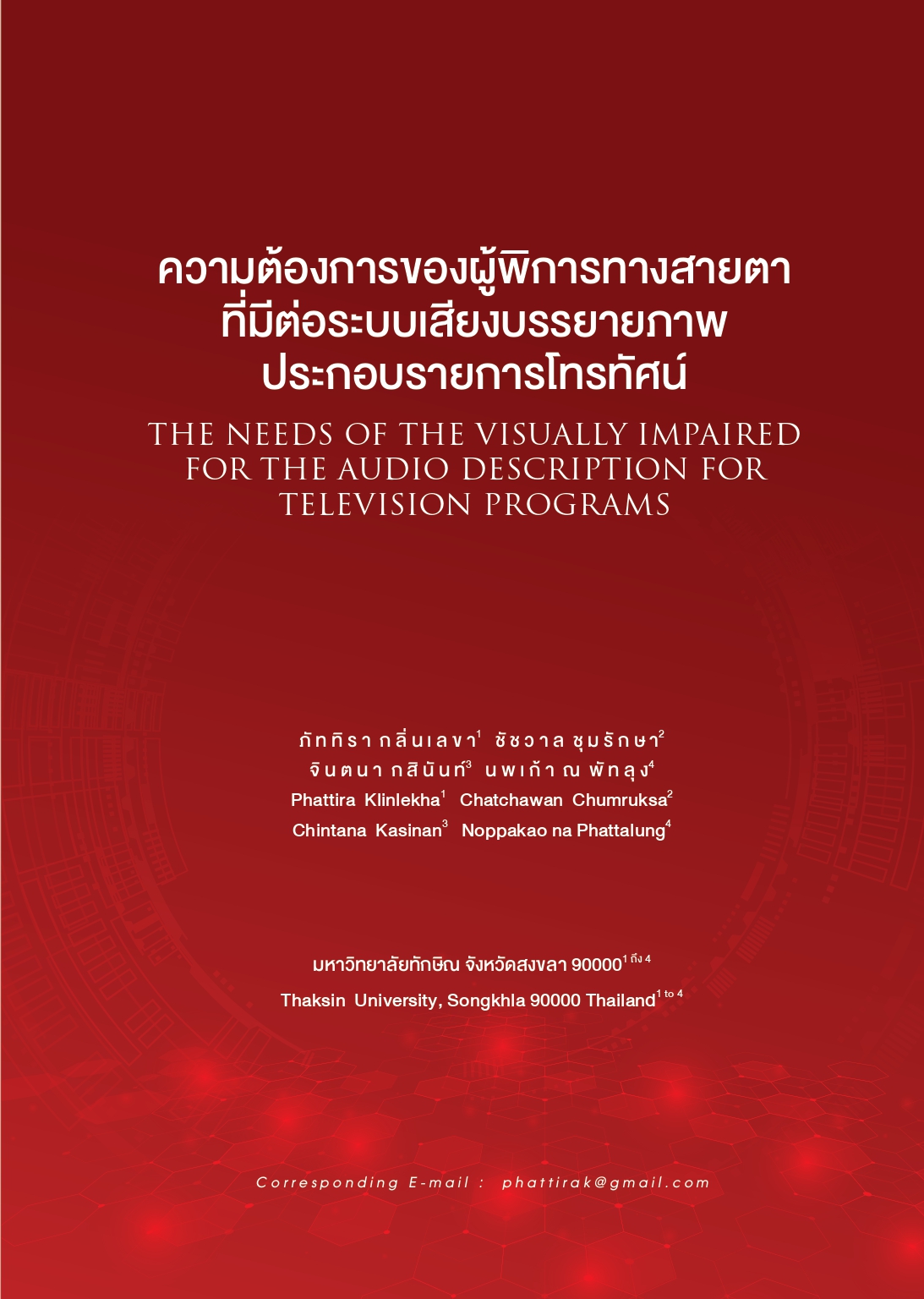The Needs of the Visually Impaired for the Audio Description for Television Programs
Keywords:
Needs, Visually impaired people, Audio Description (AD), Television programsAbstract
This survey research studies the needs of the visually impaired regarding Audio Description (AD) for television programs. Questionnaires were used to collect data from 70 visually impaired students in Grades 4-6 from seven schools under the Foundation for the Blind in Thailand under Royal Patronage countrywide. The data were then analyzed for statistics by finding mean, percentage, and standard deviation. The study found that the majority of the sample did not know that Audio Description were available on television programs. They also opined that there were not enough television programs suitable for promote or support the exposure of visually impaired people. The sample group had a high level of overall priority needs of Audio Descriptions for television programs. In terms of content, they would like to have programs with interesting, realistic, and accurate content. They also wanted more Audio Description for news programs, children and youth programs, and series. The detailed Audio Description for news programs, and clear sound describing everything on screen including parts with music or without original sound were needed.
References
จุฑารัตน์ กลิ่นค้างพลู. (2559). การวิเคราะห์ต้นทุน - ประสิทธิผลการจัดทำบริการเสียงบรรยายภาพในรายการโทรทัศน์สำหรับคนพิการทางการเห็น: กรณีศึกษาประเภทรายการที่เป็นข่าวสารหรือสาระที่เป็นประโยชน์และประเภทรายการบันเทิง. [วิทยานิพนธ์ปริญญาเศรษฐศาสตรมหาบัณฑิต]. มหาวิทยาลัยธรรมศาสตร์. https://doi.org/10.14457/TU.the.2016.689
ตรี บุญเจือ. (2562). คนพิการกับการเข้าถึงหรือรับรู้และใช้ประโยชน์จากกิจการโทรทัศน์. วารสารวิชาการ กสทช. ประจำปี 2562, 3(3), 120-147. https://so04.tcithaijo.org/index.php/NBTC_Journal/article/download/147284/156029/767661
ตรี บุญเจือ และกีรติ บุญเจือ. (2559). คนพิการกับการเข้าถึงเทคโนโลยีสื่อสารด้านกิจการกระจายเสียงและโทรทัศน์เพื่อการพัฒนาคุณภาพชีวิต: การศึกษาเชิงวิเคราะห์ วิจักษ์ และวิธาน. วารสารศาสตร์, 9(2), 210-213. https://so06.tci-thaijo.org/index.php/jcmag/article/view/158460
ธัญพร มัทวานุกูล. (2566, 11 เมษายน). สถานการณ์คนพิการ 31 มีนาคม 2566 (รายไตรมาส). กรมส่งเสริมและพัฒนาคุณภาพชีวิตคนพิการ. https://www.dep.go.th/th/law-academic/knowledge-base/disabled-person-situation/สถานการณ์คนพิการ-31-มีนาคม-2566-รายไตรมาส
ธีร์ธวัช เจนวัชรรักษ์, สุภาภรณ์ ศรีดี, และสันทัด ทองรินทร์. (2562). สถานการณ์ปัจจุบันของเสียงบรรยายภาพสำหรับรายการโทรทัศน์ในประเทศไทย: มุมมองจากผู้มีส่วนเกี่ยวข้องจากประกาศ พ.ศ. 2559 และ 2560. วารสารมนุษยศาสตร์วิชาการ, 26(1), 286-314. https://so04.tcithaijo.org/index.php/abc/article/download/111162/131900/548916
ประกาศคณะกรรมการกิจการกระจายเสียง กิจการโทรทัศน์ และกิจการโทรคมนาคมแห่งชาติ เรื่อง การส่งเสริมและคุ้มครองสิทธิของคนพิการให้เข้าถึงหรือรับรู้และใช้ประโยชน์จากรายการของกิจการโทรทัศน์. (2559, 5 กุมภาพันธ์). ราชกิจจานุเบกษา. เล่ม 133 ตอนพิเศษ 35 ง. หน้า 6-13.
ประกาศคณะกรรมการกิจการกระจายเสียง กิจการโทรทัศน์ และกิจการโทรคมนาคมแห่งชาติ เรื่อง การส่งเสริมและคุ้มครองสิทธิของคนพิการให้เข้าถึงหรือรับรู้และใช้ประโยชน์จากรายการของกิจการโทรทัศน์ (ฉบับที่ 3). (2563, 16 มีนาคม). ราชกิจจานุเบกษา. เล่ม 137 ตอนพิเศษ 60 ง. หน้า 13-14.
ภัทธีรา สารากรบริรักษ์. (2559). เสียงบรรยายภาพที่คนพิการทางการเห็นต้องการ. วารสารศาสตร์, 9(2), 168-170. https://so06.tci-thaijo.org/index.php/jcmag/article/view/158456
ศิริมิตร ประพันธ์ธุรกิจ. (2562). เรื่องชวนคิดเกี่ยวกับประเภทรายการและสัดส่วนการให้บริการสำหรับการจัดให้บริการล่ามภาษามือ คำบรรยายแทนเสียง และเสียงบรรยายภาพในกิจการโทรทัศน์ไทย. วารสารศาสตร์, 12(1), 124-127. https://so06.tci-thaijo.org/index.php/jcmag/article/view/164665/119342

Downloads
Published
How to Cite
Issue
Section
License
Copyright (c) 2023 NBTC Journal

This work is licensed under a Creative Commons Attribution-NonCommercial-NoDerivatives 4.0 International License.
The Office of the NBTC holds the copyright of articles appearing in the journal. The Office of the NBTC allows the public or individuals to distribute, copy, or republish the work under a Creative Commons license (CC), with attribution (BY), No Derivatives (ND) and NonCommercial (NC); unless written permission is received from the Office of the NBTC.
Text, tables, and figures that appear in articles accepted for publication in this journal are personal opinion and responsibility of the author, and not binding on the NBTC and the Office of the NBTC. In case of errors, each author is solely responsible for their own article, and not concerning the NBTC and the NBTC Office in any way.


